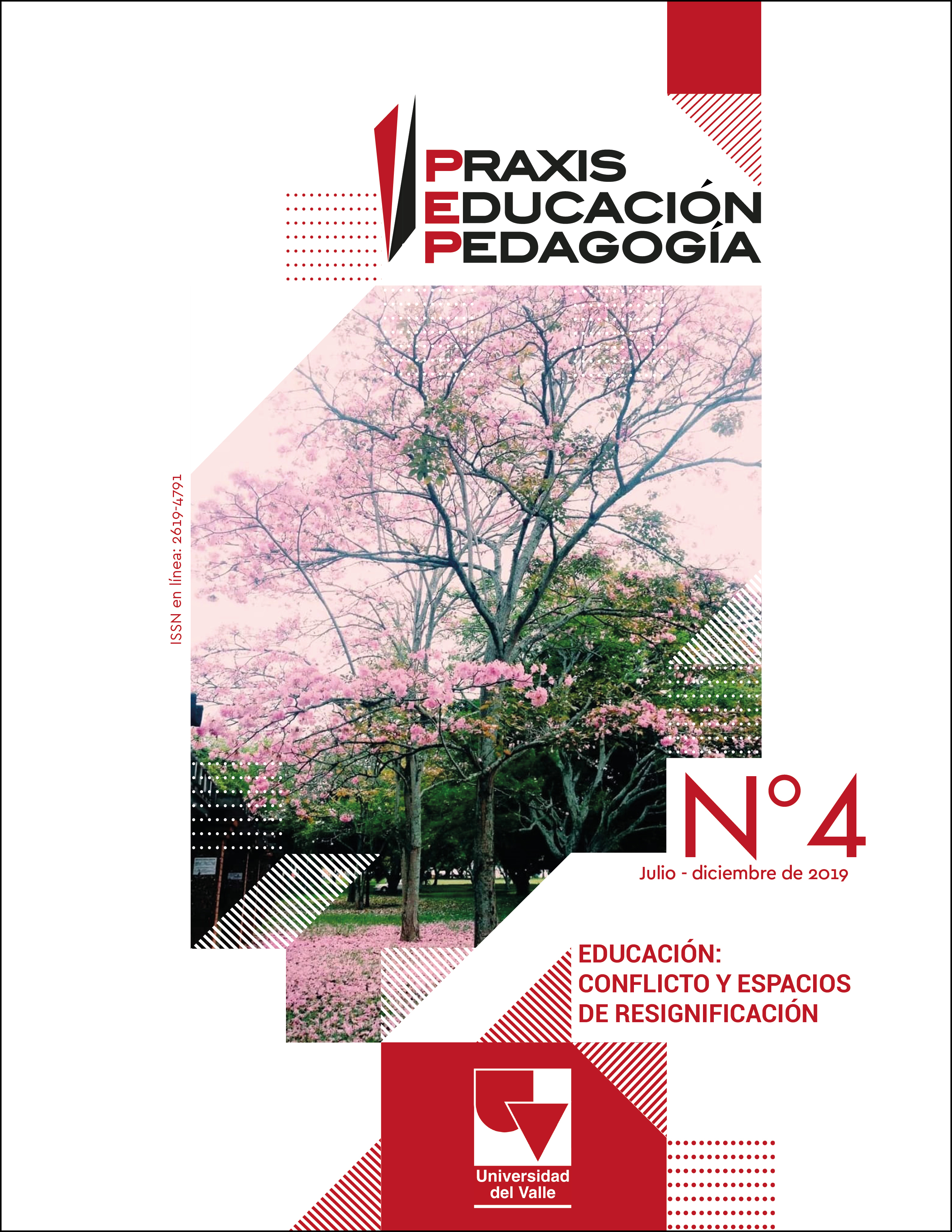Research for the creation of meaningful experiences at school
Main Article Content
One of the most important roles of the research, in the midst of reflecting on its epistemic foundation, consists in understanding how it is possible to create and (re) design spaces for training in contemporary schools. In this sense, it is necessary to return to the approaches of research in design and creation, usual referents in the formative practice of the arts, aesthetics and visual studies, as foundational bases for new ways of designing the experience with which students and teachers transform their living spaces: the neighborhood, the commune, the neighborhood, among many other settings.
Therefore, in this article a review is carried out around aesthetics and contemporary visual studies as scenarios where the curriculum is (re) configured as a life experience. The image, the gestures, the creation process, the color, the material become practical exercises to (re) think about the current pedagogy and its correspondence with the ethical and aesthetic training of future citizens.
The structure of this article is understood under two questions and a training model for meaningful experiences in school. The first question brings us closer to questioning the role of research in design and creation for school planning. The second concern is called under the question: What is the ethical and aesthetic impact on the configuration of being a teacher and student today? The third and last section of the article presents the training experience called “Centro de Investigación Escolar: Diseñando la Ciudad, en el Barrio Olaya Herrera de la ciudad de Medellín”.
- Research
- Creation
- High school
- Educational planning
- Educational strategies
Amengual, G. (2007). El concepto de experiencia: de Kant a Hegel. Tópicos, (15), 5-30.
Barilli, R. (1984) El arte contemporáneo, de Cézanne a las últimas tendencias. El Informalismo. Bogotá: Editorial Norma.
Checa Olmos, F., Arjona Gariddo, A. y Checa Olmos J. (2007) El extrañamiento cultural en espacios migratorios: La juventud andaluza ante el reto de la multiculturalidad. Revista Dialnet, 4(1), 111-140. Recuperado de: https://dialnet.unirioja.es/servlet/articulo?codigo=2380409
Dewey, J. (1952) El Arte como Experiencia. Argentina: Ed. Paidós.
Gumucio-Dagrón, A. (2011) Comunicación para el cambio social: clave del desarrollo participativo. Signo y Pensamiento, XXX(58), 26-39.
Jakobson, R.., Waugh, L. R., & Taylor, M. (1987). La forma sonora de la lengua. México: Fondo para la Cultura Económica.
Ministerio de Educación Nacional (2006) Estándares Básicos de Competencias en lenguaje, Matemáticas, ciencias y ciudadanas. Bogotá –Colombia: Ministerio de Educación Nacional.
Ministerio de Educación Nacional (2010) Niveles de la educación básica y media. Bogotá: Ministerio de Educación Nacional.
Montessori, M. (1915) Manual práctico del método Montessori Ideas generales sobre el método. Madrid: Editorial Oveja Negra.
Press, M. & Cooper, R. (2009). El diseño como experiencia. El papel del diseño y los diseñadores en el siglo XXI. Barcelona: GG Diseño.
Piaget, J. Deslex, A., Claparède, É., & Barnés, D. (1931) El lenguaje y el pensamiento en el niño. Madrid: Editorial Oveja Negra.
Rauschenberg, R. (1952). Postcard Self-Portrait, Black Mountain (I) [Gelatin silver print]. Beijing, UCCA. Recuperado de: https://www.rauschenbergfoundation.org/art/artwork/postcard-self-portrait-black-mountain-i
Restrepo, J. A. (1996) Musa Paradisiaca [Videoinstalación]. Bogotá, ArteFlora. Recuperado de: http://arteflora.org/exposiciones/musa-paradisiaca-jose-alejandro-restrepo/
Ricupero, S. (2007). El diseño gráfico en el Aula. Buenos Aires: Editorial Nobuko.
Salcedo, D. (2018) Fragmentos [Contramonumento]. Bogotá, Museo Nacional de Colombia. Recuperado de: http://www.museonacional.gov.co/noticias/Paginas/Fragmentos.aspx
Salcedo, D. (2019) Quebrantos [Instalación]. Bogotá, Patrimonio Cultural de Bogotá. Recuperado de: http://patrimoniocultural.bogota.unal.edu.co/eventos/article/quebrantos-accion-de-duelo-monumental-por-los-lideres-asesinados-doris-salcedo.html
Shannon, C.E. & Weaver, W. (1948) The Mathematical Theory of Communication. Illinios: University of Illinios Press.
Silva. A. (2014). Atmósferas ciudadanas: grafiti, arte público, nichos estéticos. Quito: Editorial Quipus, Ciespal.
Taborda, J.C. (2015, Agosto 17). Entrevista con Juan Carlos Taborda, estudiante miembro del Centro de Investigación Escolar Barrio Olaya Herrera. Medellín: Taller de investigación I.E. Barrio Olaya Herrera.
Urueña, J. (2015) La investigación escolar como la transformación del barrio desde un enfoque de la comunicación para el cambio social. Medellín: Programa Ondas Colciencias.
Downloads

This work is licensed under a Creative Commons Attribution-NonCommercial-ShareAlike 4.0 International License.





